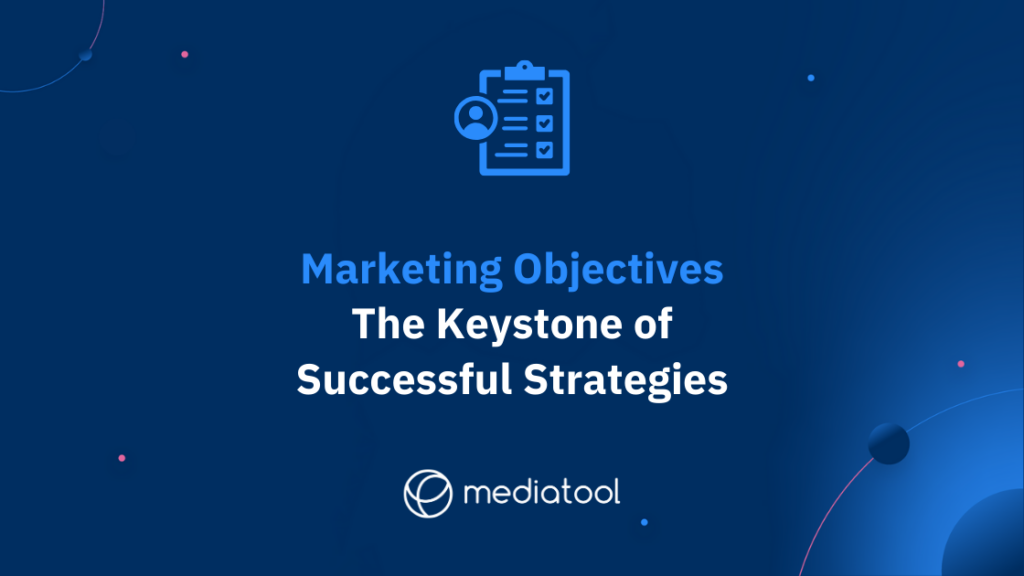In this article, we’ll dive into the essence of what marketing objectives are and why they are indispensable in aligning your marketing efforts with your overall business goals.
From increasing brand awareness to driving website traffic and customer acquisition, we’ll discuss how these objectives not only keep your team on track but also ensure every marketing action contributes meaningfully to your larger business aspirations.
What Are Marketing Objectives?
These objectives are specific goals the marketing team sets to guide their marketing efforts. Whether it’s to increase brand awareness, ramp up website traffic, or acquire new customers, marketing objectives keep everyone on track.
Why Are Marketing Objectives Important?
Aligning with Business Goals
These objectives align the marketing team’s actions with the overall business goals.
Whether the aim is to become a market leader, boost market share, or increase sales, marketing objectives act as a strategic compass. They provide direction and focus, ensuring that every marketing effort, from digital campaigns to content marketing, contributes to larger business objectives.
In 2024, a significant 50 percent of marketers intend to increase their investment in content marketing, indicating a strategic shift towards enhancing content-driven initiatives.
Targeting and Customer Engagement
In the digital age, understanding and targeting the right audience is more important than ever. Marketing objectives help businesses tailor their marketing strategies to attract their target audience.
This involves drawing in more website visitors, increasing social media impressions, or expanding into new markets. By setting clear marketing objectives, companies can effectively engage with potential customers, retain current ones, and even convert customers into brand ambassadors.
B2B marketing statistics for 2024 highlight a high emphasis on understanding audience needs and aligning content with organizational objectives, underscoring the importance of targeted marketing efforts in this context.
Measuring Success through Key Performance Indicators
One of the key aspects of marketing objectives is their measurability. Using tools like Google Analytics, businesses can track specific metrics like website traffic, conversion rates, and social media engagement.
These measurable marketing objectives allow teams to assess the effectiveness of their marketing campaigns and adjust strategies as needed. Organizations can see tangible results from their marketing efforts by focusing on specific goals like increasing customer lifetime value or improving brand awareness.
Driving Growth and Customer Acquisition
Effective marketing objectives are essential for driving business growth. They help sales teams understand and meet their sales process goals, leading to more leads, higher sales, and increased revenue.
Good marketing objectives also focus on customer acquisition, guiding marketing campaigns to attract new customers and enter new markets. They ensure that marketing activities are not just random shots in the dark but are strategic moves toward defined objectives.
Building Brand Authority and Recognition
In today’s competitive landscape, building brand authority and recognition is crucial. Marketing objectives that focus on brand awareness, customer loyalty, and positive reviews help establish a business as an authority in its field.
By setting and achieving these objectives, companies can improve brand recognition, leading to a more robust sales pipeline and a larger market share.
Marketing Objective Examples

To illustrate the practical application of marketing objectives in a business context, let’s explore some concrete marketing objectives examples. These examples showcase how specific goals can guide a company’s strategy and actions in various key areas.
Boosting Sales
A timeless marketing objective is increasing sales, an essential part of any business’s growth strategy. For example, a company might set a clear marketing goal to increase sales by 20% by the end of the fiscal year.
This objective can be broken down into smaller, manageable targets for the sales team, involving tactics like improving the sales process, enhancing customer engagement, and exploring new markets.
Enhancing Social Media Engagement
In today’s digital world, enhancing social media engagement is crucial. A measurable marketing objective could be achieving a 30% increase in social media impressions within six months.
This involves the marketing team formulating a robust social media strategy, focusing on content marketing that resonates with the target audience and using key performance indicators to track social media activities and their impact on brand awareness.
Growing Website Traffic
Increasing website traffic is a significant marketing objective for many businesses, aiming to attract more website visitors and potential customers. A specific goal might be to increase website traffic by 25% over the next quarter.
To achieve this, marketing efforts could include:
- Optimizing digital marketing campaigns.
- Utilizing Google Analytics for insights.
- Enhancing the user experience to retain visitors and convert them into customers.
Expanding Market Share
Another vital marketing objective is to expand market share. For instance, a company could aim to increase its market share by 15% within a year. This objective requires comprehensive market research, identifying new target audiences, and tailoring marketing campaigns to these groups.
It involves evaluating current marketing strategies and adjusting them to outperform competitors and become a market leader.
Improving Customer Acquisition and Retention
Improving customer acquisition and retention is a multifaceted objective. A business might set a goal to increase customer acquisition by 20% and improve customer retention rates by 10% over the next year.
This objective involves various marketing activities, from lead generation to creating positive customer experiences, which could lead to more positive reviews and a stronger brand reputation. It also emphasizes the importance of building customer loyalty and increasing customer lifetime value.
For customer acquisition and retention, focusing on building trust with consumers is key. Trust for both established and new businesses is predicted to decline by 10% in 2024, emphasizing the importance of aligning brand values with customer experiences to maintain and grow customer loyalty.
These examples of marketing objectives show how they guide businesses in various aspects, from increasing brand authority to acquiring more leads and improving the profit margin. Each objective is time-bound, measurable, and aligned with the overall marketing plan and business goals. They are not just aspirations but are defined objectives that drive every action of the marketing teams, ensuring consistent messaging and a focused approach to achieving business success.
Hallmarks of Effective Marketing Objectives

Adhering to the SMART Criteria
Effective marketing objectives don’t just emerge spontaneously; they’re crafted with precision and clarity, adhering to the SMART criteria. These objectives are:
- Specific: Targeting clear, well-defined goals. Whether it’s increasing website traffic or boosting customer retention, each objective must pinpoint a specific area of improvement.
- Measurable: Utilize key performance indicators and tools like Google Analytics to measure progress quantifiably. This could be tracking the growth in social media impressions or the new customer acquisition rate.
- Achievable: Setting realistic targets that challenge the marketing team yet remain attainable. It’s about striking the right balance between ambition and practicality.
- Relevant: Aligning with the broader marketing strategy and overall business goals, whether becoming a market leader or enhancing brand recognition.
- Time-bound: Having a clear deadline, creating urgency and focus. This might mean setting a six-month goal for increasing sales or a one-year target for expanding market share.
Clarity and Comprehensibility
For marketing objectives to be effective, they must be clear and understandable, not just to the marketing teams but across the organization. They should guide all marketing efforts, from content marketing to digital campaigns, ensuring every action contributes to these overarching goals.
Alignment with Business Goals
Effective marketing objectives are intrinsically linked to the organization’s broader business goals. They support crucial aims like improving profit margins, enhancing customer lifetime value, and expanding the sales pipeline.
This alignment ensures that the marketing strategy not only pursues its own objectives but also contributes significantly to the company’s overall success.
Driving Marketing Strategies and Campaigns
These objectives are the driving force behind all marketing activities and campaigns. They dictate the approach for engaging the target audience, dictate the content of marketing campaigns, and determine the channels for customer engagement.
AI is becoming increasingly important.
A significant 64 percent of marketers have already adopted AI as a core element of their strategy, with an additional 38 percent planning to start by 2024. This adoption rate underscores the growing importance of integrating advanced technologies like AI in driving effective and innovative marketing strategies.
By focusing on specific areas such as lead generation, brand awareness, or increasing social media engagement, these objectives ensure that every marketing effort is purposeful, data-driven, and results-oriented.
Fostering Growth and Innovation
Lastly, well-defined marketing objectives encourage growth and innovation within the marketing department and the broader organization. They challenge marketing teams to explore new markets, engage with potential customers in novel ways, and constantly refine their marketing strategies to achieve these goals.
How to Set Great Marketing Objectives for Your Business
Conducting In-Depth Market Research
The foundation of setting impactful marketing objectives is rooted in comprehensive market research. This step is crucial for understanding your target audience’s needs and preferences. Dive deep into analyzing your competitors and staying abreast of current market trends.
According to Qualtrics (2024), AI innovations in market research are helping organizations make smarter decisions more quickly. In fact, 62% of researchers report that their company relies significantly more on research and insights today than in the past two years. This trend underscores the growing importance of market research in the digital age.
Utilize tools like Google Analytics to gather vital data, informing your approach to increasing brand awareness or penetrating new market segments.
Brainstorming with Marketing Teams
Once you have all the data, bring your marketing teams together for a brainstorming session. Encourage open discussions to generate creative and innovative ideas for your marketing campaigns. This collaborative approach is key to formulating objectives that are not only ambitious but also grounded in reality.
Setting Ambitious Yet Achievable Goals
Your marketing objectives should strike a balance between aspiration and attainability. Aim to set goals that challenge your team but are still within reach. Such objectives could include increasing social media impressions, enhancing brand awareness, or expanding the customer base.
Defining these goals clearly is essential to ensure everyone is working towards the same end.
Incorporating SMART Principles
Adopt the SMART framework for your objectives. This means setting Specific, Measurable, Achievable, Relevant, and Time-bound goals. For instance, a good marketing objective could be to increase revenue by 20% in the next fiscal year through targeted marketing campaigns or boost customer lifetime value by enhancing after-sales support and engagement strategies.
Aligning with Sales and Broader Business Goals
Ensure that your marketing objectives align with the sales team’s goals and the overall business objectives. This alignment ensures that your marketing efforts contribute directly to the bottom line, whether through acquiring more customers, retaining existing ones, or educating prospects about your products or services.
Focusing on Continuous Improvement and Adaptation
Finally, be prepared to continually assess and adapt your objectives. The business landscape is ever-changing, and your marketing objectives should evolve accordingly. Regularly review your goals, measure their effectiveness, and make necessary adjustments to stay on course.
Conclusion
Marketing objectives are the compass guiding businesses through the ever-evolving landscape of commerce. These objectives are pivotal in crafting effective marketing campaigns and defining the direction of various marketing channels. For instance, an example objective might be to increase social media impressions, directly supporting the broader marketing goals of enhancing online presence.
The alignment of marketing objectives with the sales team’s targets is essential. It ensures that every strategy, whether aimed at customer retention or expanding to a new target audience, contributes meaningfully to the overall business objectives. This synergy is vital for increasing customer lifetime value and driving growth.
Moreover, marketing objectives provide a clear focus for businesses. They aid in developing campaigns that resonate with current market dynamics, ensuring that efforts are not just well-intentioned but also strategically sound and effective. These objectives are the lighthouse for sales reps and marketers alike, illuminating the path to achieving key marketing goals and business success.





